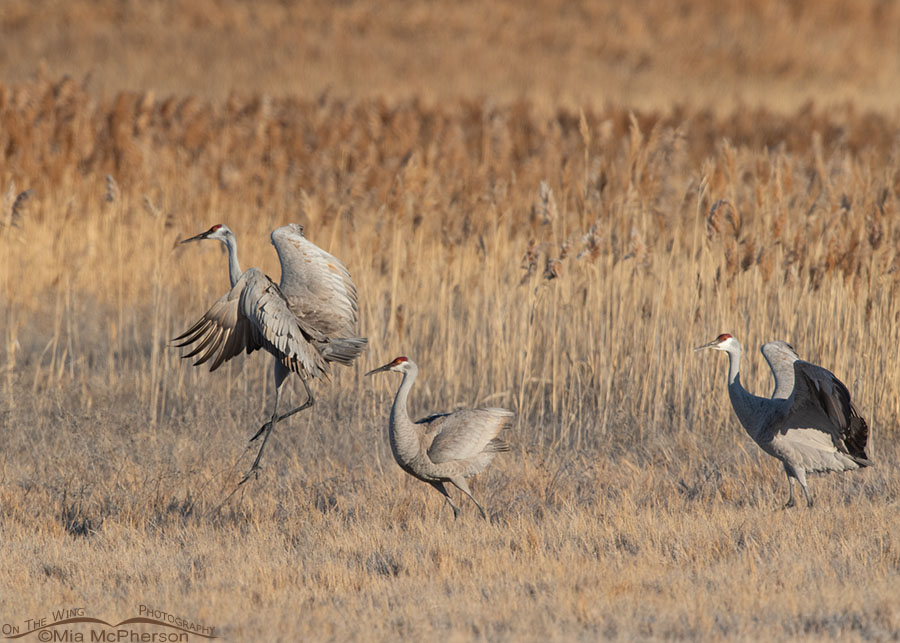 Three Sandhill Cranes displaying in spring
Three Sandhill Cranes displaying in spring
On September 2nd I became aware of a Sandhill Crane being killed by Utah’s DWR (Division of Wildlife Resources) in close proximity to the privately owned River’s Edge Campground near Heber, UT which is east of where I live via a Facebook post. The distraught person who wrote the post witnessed the crane being killed and somehow this event also cost the life of his dog.
The person wrote that “Bob” the Sandhill crane had pecked at the Ford pickup of a DWR officer who had recently moved in near him. This incident apparently occurred on August 27. Apparently this officer was made aware that the cranes, Bob and his mate Betty, had previously pecked at other vehicles.
Someone in the Utah DWR allegedly contacted their veterinarian about the crane’s behavior and some other veterinarians at USU who, as noted in this article, are “kind of avian specialists.”
Kind of?
What?
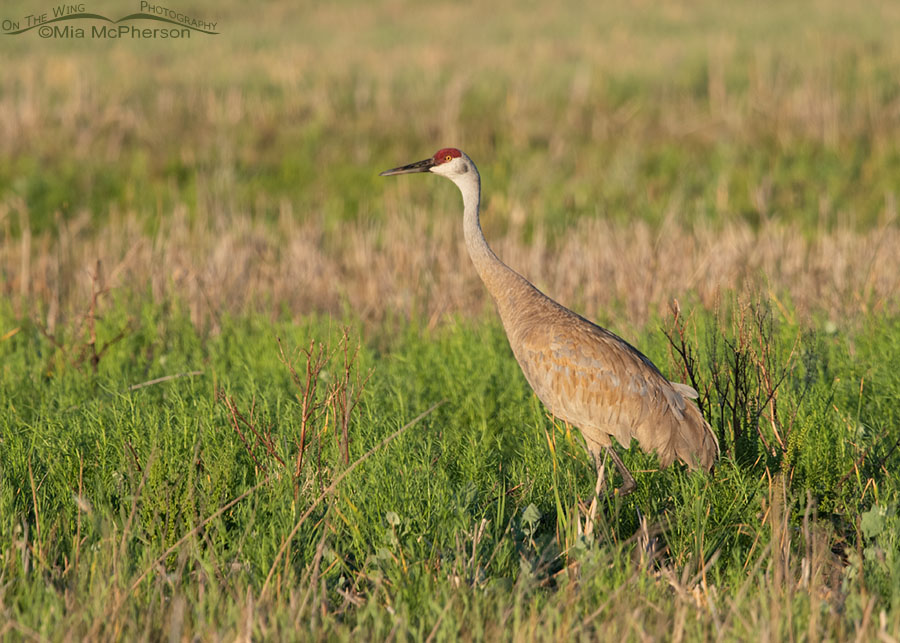 Adult Sandhill Crane in a field at Bear River MBR
Adult Sandhill Crane in a field at Bear River MBR
The Utah DWR and USU veterinarians somehow came to the conclusion that the Sandhill Cranes, Bob and Betty, weren’t acting normally and that the birds could potentially be exhibiting symptoms common with neurological disease, such as West Nile or some kind of toxin ingestion. An order was given to kill the Sandhill Cranes to test them for toxins by doing a necropsy.
Utah DWR officers found the cranes at the campground and they state that the cranes took off and flew to public lands which is where Bob the Sandhill Crane was shot and killed. The female crane, Betty, escaped being shot to death.
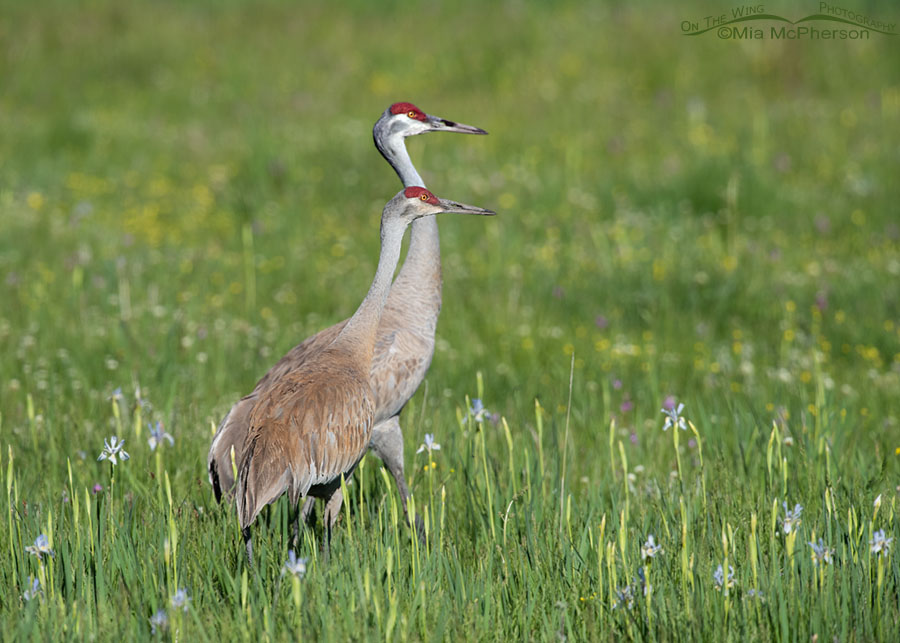 Mated pair of Sandhill Cranes in Beaverhead County, Montana
Mated pair of Sandhill Cranes in Beaverhead County, Montana
I’ve been around lots of Sandhill Cranes in Florida, Utah, and Montana. In Florida Sandhill Cranes pecking at windows, mirrors, and other shiny surfaces such as the sides of a pickup truck isn’t considered “abnormal” crane behavior at all.
Birds of all sizes peck at windows, shiny surfaces, and mirrors because they see their reflection and peck at the “intruders” in their territories. This behavior is completely normal and it certainly does not indicate that the birds are ill, suffering from toxins, or that they have neurological deficits.
Birders know this. Bird photographers know this. Birdwatchers know this. Why didn’t these vets and DWR officers and officials know this?
Yes, a Sandhill Crane can do damage to mirrors, the side panels of pickups, or to other shiny surfaces because they are large birds.
They also mate for life which can be as long as 36 years. Bob was probably just defending his mate and/or his territory when he saw his reflection on the pickup truck.
Here is an article about a crane in Florida who saw their reflection in a window in Florida. WATCH: Perturbed Sandhill Crane Attacks It’s Own Reflection in a Glass Door
An article from Illinois that shows a perfectly healthy Sandhill Crane attacking the shiny side of a pickup with tips on how to prevent pecking from occurring.
And another from CraneWatch.org that answers the question “Why do cranes peck at peoples’ windows” that offers tips on how to deter cranes from the same activity that Bob the Sandhill Crane was killed for.
Cranes in Florida aren’t being killed because they peck on vehicles.
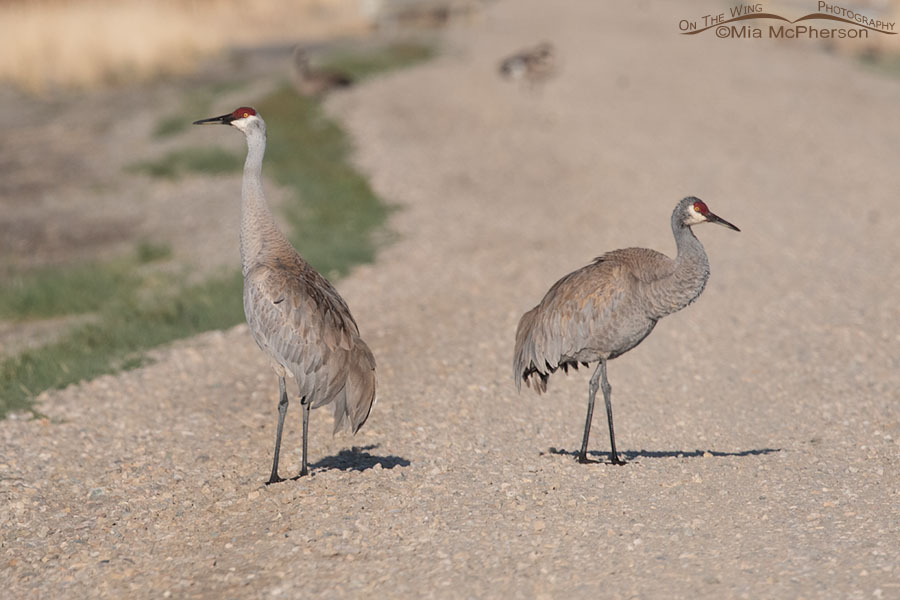 Mated Sandhill Cranes on the auto tour at Bear River MBR
Mated Sandhill Cranes on the auto tour at Bear River MBR
I believe that Bob, the Sandhill Crane, was just doing what birds do and that Utah DWR jumped the gun and used lethal methods instead of slowing down and talking to experts in avian behavior who know that birds peck on shiny things.
Cranes are well known for being territorial. Sandhill Cranes will also defend their nests, mates, and young even from apex predators such as coyotes and gators. Yet if you leave them alone they will leave you alone.
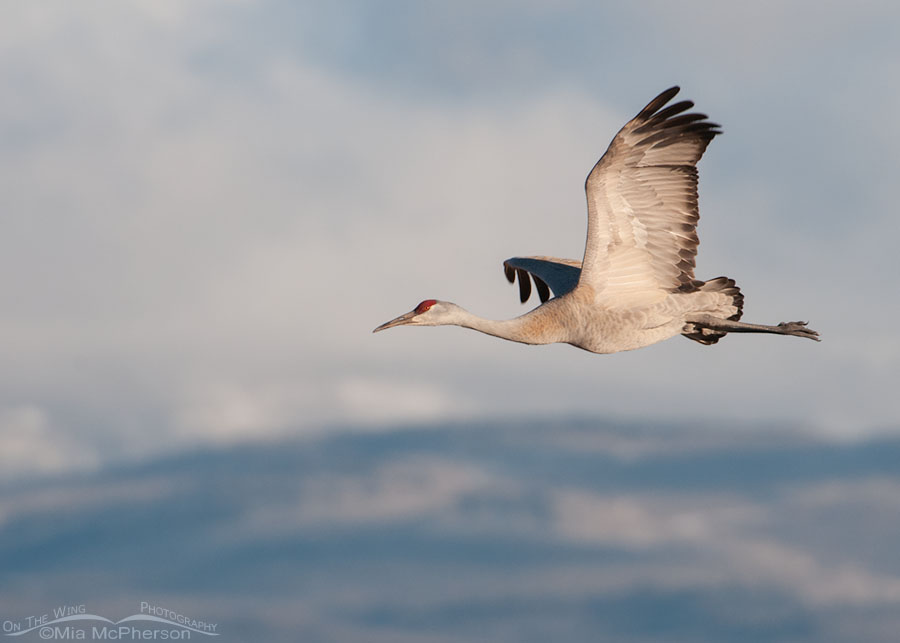 Adult Sandhill Crane in flight in front of spring storm clouds
Adult Sandhill Crane in flight in front of spring storm clouds
One of the other things that made me upset with Bob the Sandhill Crane being killed is that this could have been prevented. DWR could have hazed the cranes. Hazing works given time and effort.
Putting plastic bags over the mirrors on vehicles can help, if they can’t see their reflection they don’t fight the “intruder” and they leave the mirrors alone.
Cheap tarps thrown over the sides of shiny Ford pickups have been shown to reduce the chances of damage being done.
There are more measures that could have, and in my humble opinion should have, been taken prior to killing Bob the Sandhill Crane.
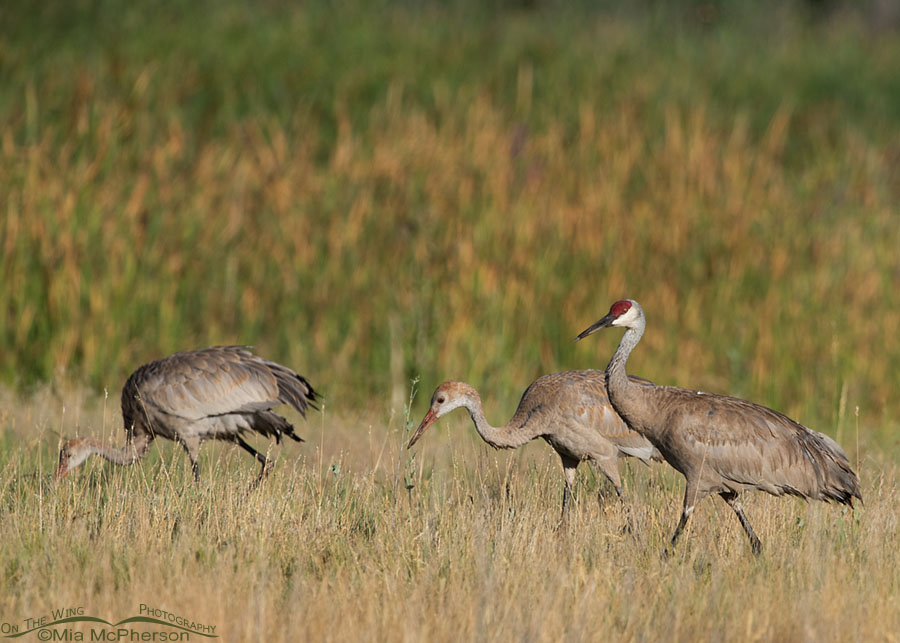 Sandhill Crane family at Farmington Bay WMA
Sandhill Crane family at Farmington Bay WMA
Additionally, fall migration is just around the corner for Sandhill Cranes in Utah. Bob and his mate Betty would have soon been on the wing to their wintering grounds. Was that fact even taken into consideration before Bob was killed for doing what birds do?
In the spring measures could have been taken to make sure Bob and Betty moved some place where they wouldn’t have become so accustomed and acclimated to human presence.
For Bob the Sandhill Crane it is too late.
Was the killing of Bob the Sandhill Crane really necessary?
I honestly don’t think it was. The nuisance animals in this case, were the humans, not the cranes.
Mia
Notes:
- I have no information on how the dog of the original poster on Facebook was killed and can’t provide any further information on that.
- The names Bob and Betty were given to the cranes by the people who have enjoyed watching them just being cranes for several years.
- I̶ ̶h̶a̶v̶e̶ ̶n̶o̶t̶ ̶s̶e̶e̶n̶ ̶t̶h̶e̶ ̶t̶o̶x̶i̶c̶o̶l̶o̶g̶y̶ ̶r̶e̶s̶u̶l̶t̶s̶ ̶f̶r̶o̶m̶ ̶t̶h̶e̶ ̶n̶e̶c̶r̶o̶p̶s̶y̶.̶ The original poster on the death of Bob the Crane has seen the results of the necropsy. Bob the Crane did not have West Nile and he was not sick in any way.
- I’ve always said that I feel obligated to speak for those who can’t speak for themselves. Today, I am speaking for Bob the Sandhill Crane.
Click here to see more of my Sandhill Crane photos plus facts and information about this species.


Terrible, I walk the trail with my dogs several times a week and I know I’ve seen Bob and Betty. Unfortunatly, buaracracy is within the system at the DWR. Sad day for birds and bierders
We do not care for the world around us. We prove it over and over. This is so disheartening. Thank you for speaking out.
I’m appalled. Information is so readily available for everyone. I feel that those involved who should be knowledgeable or at the very least able to Google- be in some way punished, and required to do volunteer service with a rehab facility. It would be nice if something positive could come from this terrible incident.
Thanks for this post Mia.
This story is tragic, and so unnecessary.
Your opinion is not humble – it’s incredibly valuable, backed by years of accumulated experience and knowledge.
Thanks again ~
There are many good comments about this horrific act by a government official who should know better. Is there someone we should write to about this? I live in California and actually work with a couple of CDFW biologists and I will pass this on to them and get their input. Thanks so much for your beautiful photography and sharing this. So sad for Betty and hope she will be alright.
I hope the area Audubon chapters will weigh in on this situation and provide training that these inexperienced “officials” are needing. Here, we have turkeys, pheasants, Ravens and others pecking on sliding glass doors, and vehicles parked outside. About the only downside is needing to sweep up after they leave. As for the deer, elk, bears, foxes, coyotes, and skunks that stroll through their territory (our yard), we try to monitor our own behavior not to provoke problems due to human carelessness.
In my opinion most Veterinarians don’t have the expertise in bird behaviour as much as a wildlife Biologist does. I have seen Wild Turkeys with this same behaviour and they have not been destroyed because of it. My heart breaks for Bob & Betty and the folks who knew & loved them.
Utah DNR needs to get educated about the birds & wildlife that inhabit their State…. This was such an ignirant action on their part!
Seems to me that these agents need training in birds and other wildlife. Perhaps this job is not for them as they took the easiest and most convenient action for themselves and did not know enough or care enough about the birds. SHAME!
It is very disturbing to hear this. I lived in Florida for 10 years on the edge of a swampy Reserve. We had sandhill cranes peck at our sliding glass door mostly during mating and nesting season. We started putting coverings on the sliding glass windows to keep the reflection down for them. I’m not an expert on birds, but I know sandhill cranes mate for life. I’m only someone who enjoys nature, but I expect people hired by state and local wildlife government organizations to be EXPERTS and know animal behavior better than I do. I will share your blog on social media, because the killing of Bob was stupid, thoughtless and without any regard to the natural behavior of these beautiful birds.
This is so sad. The cardinals which peck at my side mirrors do not do this because they have West Nile disease. Even the vultures which chew the rubber on auto windshields and pick away the molding around windshields of cars parked in Everglades National Park are not executed. Instead, as you mention, visitors are given protective tarps to cover their autos.
So sorry reading about this ill-advised action. I agree that hazing would have been a better solution. And it is very concerning that vets which were “kind of avian specialists” were the consulted “experts” – that is just irresponsible. Thanks for pointing out this story.
Sorry to hear about Bob. I have always said, “It is not wildlife that needs management, it is humans that need management”.
So well said, Mark. So well said.
A loud and emphatic YES from here too.
My county of Mendocino rallied together to end lethal wildlife resolutions just this last month. If you or a group were so inclined, make a stink about this. Get it into the newspaper, call your government folks, write a letter to every editor…
This was an unnecessary death.
Really stupid action by Utah game dept. You would think that they would be more interested in saving wildlife.
Grrrgh ! Absolutely, totally unconscionable; this act could never be justified. But this is just one small instance of the wholesale slaughter we have inflicted and continue to inflict upon other species and even the vulnerable of our own species. Another reason why there are an increasing number of times when I find it difficult to be sorry that the time for homo sapiens may be coming to an end. Guess that is why they call us Raging Grannies.
When I read your article about what was done to Bob, I broke out into a sweat. I hope you will publish it in local newspapers and anywhere else where it will get in creased exposure. Bob should not have died in vain at the hands of these idiots. I cry too at the thought of Betty grieving for her partner.
If this is the kind of resources Utah wildlife has, no wonder wildlife numbers are declining.
It’s hard to imagine any state or federal agency killing a BIRD– especially a paired-for-life migratory species. Because it pecked on a vehicle window? Hazing it would have been sufficient!
NO, it wasn’t necessary to kill Bob the Sandhill Crane for all the reasons that you have given. Good grief, do they not have better things to do than go for knee-jerk reactions. Disgusting.
If we live by this, “Eye for an eye” DWR action in our society, I would be justified in “euthanizing” the people who have “pecked at” my car door this week twice this week. Perhaps they have a virus? Oh, I am so sorry. Do I seem like I am overreacting? Stupid is as stupid does and unfortunately, stupid does just too much in this state.
And thepark city radio made this sound like a real safety issue…….
Wonder if the DNR truck gets scratches on it doing its job, if it ever leaves the pavement? ?
And please investagate the death of the small dog, that lived at rivers edge, by either the DNR officer, or the people that terminated BOB,
guess may be the cant see ducks, skunks, raccoons, or marmots while driving there vehicles either…….this whole things stinks of over reaction…….like normal……